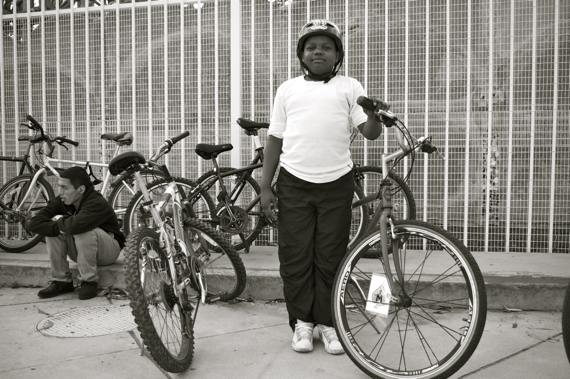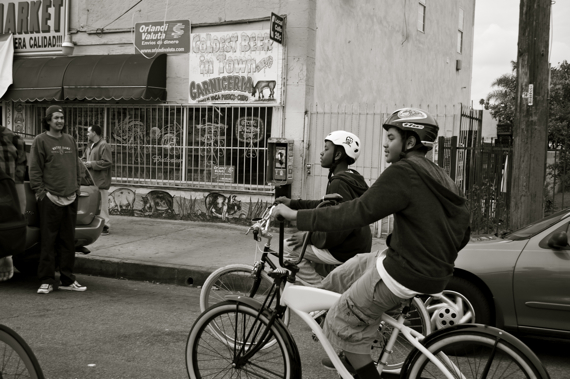A Ride to the Watts Towers: More than a Ride to the Watts Towers
10:17 AM PST on February 7, 2012

Several years ago, I spent a week photographing a stretch of 37th St. as part of a neighborhood documentation project of the area around USC. Where other photographers had diligently snapped structures and streets, I had cajoled residents into participating in the project and later gave them copies of the photos so they could see the final product. The soul of a neighborhood is its people, I had argued in defending my approach at the time. Without them, the structures are just a shell.
I was reminded of this while surveying the scene at Augustus Hawkins Natural Park on a chilly Sunday morning in late January. About 60 riders had shown up to participate in the CicLAvia South L.A. Exploration Ride through Watts. Each had a different motivation for being there. Some simply enjoyed participating in exploratory group rides. Those unfamiliar with the area came to check out our landmark destination, the Watts Towers. Others were linked to the CicLAvia South L.A. Host Committee, TRUST South L.A., C.I.C.L.E., or the BikeRoWave, the groups facilitating the ride. Still others were from the Watts-based East Side Riders (ESR), eager to make the case for Watts to be included in the CicLAvia expansion route.
Finally, a sizable contingent—at least 20%—came to document the ride, including the L.A. Times, KPCC's OnCentral, the Annenberg Innovation Lab, filmmakers from Ride: In Living Color, folks from ParTour (a USC initiative harnessing new media and mobile technology to advance positive social change), and, of course, Streetsblog. The apparent newsworthiness of this crossing of socio-economic boundaries served to underscore how infrequently it occurs, even in a city as diverse as ours.
The ride was a continuation of the Committee's efforts to host monthly rides into South LA. The larger purpose was to promote cycling and show the value of livable streets in communities, bridge gaps between communities by helping people explore new areas, demonstrate proper riding techniques and the rules of the road, and, in the case of ParTour, to engage participants in the creation of a crowd-sourced map of the route to showcase South L.A. as a rideable destination.
On just about all those counts, the organizers of the ride could consider it to have been incredibly successful, something for which they should be commended.
Seeing curious faces poking their heads out of doors and windows as we rolled by, however, I wondered if residents viewed the successes in the same way. To what extent did they grasp the goals of the ride or feel inspired by seeing bikers pass down their streets? Know about (or even have an interest in) the crowd-sourced map? Or agree that bridges were being built between their community and others?
It was hard to know, as, for the most part, we did not stop to interact with those who smiled and waved their greetings as we passed.
Some members of the ESR who had grown up along these streets voiced frustration that this was an important part of the real Watts that we were missing: the people. Moreover, the limited amount of time we would be in the neighborhood and a desire to see CicLAvia extend southward seemed to add to the pressure they felt to make sure participants would see enough to appreciate the community for what it was. Simply riding a route to a landmark, they noted, did little to help others see their community a destination.
To mitigate some of these concerns, both the ESR and the ride organizers had collaborated to work in a stop at the Watts Labor Community Action Committee (WLCAC) to begin the process of bridge-building. It was a great move—a number of the riders in the group mentioned being inspired by the talk given by the WLCAC's president and CEO, Tim Watkins, about the community and their work, and said they had not known about the WLCAC prior to visiting.
Post-talk, riders gathered together for a group photo at the Mother of Humanity statue, agreed it had been a fun ride, and then hit the road, headed back to the original starting point.
Lovely a ride as it was, would people return on their own to visit the community? Would people in the community now feel inspired to take back the streets for bikes? What were the longer-term gains for the community? What should they be?

There is only so much that can be accomplished with a single ride event. But if we seek to use cycling to bridge divides and make the communities themselves the destinations, then we may need to think about innovative ways to get more out of future such events. Cyclists tend to focus on finding routes that make it easy to move through places to points of interest when mapping rides. Thus, when community is built, it tends to be among those participating in the ride, not with those we pedal by. Genuine, sustainable bridges between communities clearly requires greater engagement of the residents of an area — both cyclists and non-cyclists — in such a way that the people of a community are able to participate in and contribute to the experience.
But what does that look like in practice? How much and what kind of outreach does that require? To figure it out, over the next few weeks, I will be retracing some of the route taken through Watts that day and interviewing residents to get their perspectives on these and the other questions raised above. Stay tuned for part two...
Sahra is Communities Editor for Streetsblog L.A., covering the intersection of mobility with race, class, history, representation, policing, housing, health, culture, community, and access to the public space in Boyle Heights and South Central Los Angeles.
Stay in touch
Sign up for our free newsletter
More from Streetsblog Los Angeles
Eyes on the Street: New Lincoln Park Avenue Bike Lanes
The recently installed 1.25-mile long bikeway spans Lincoln Park Avenue, Flora Avenue, and Sierra Street - it's arguably the first new bike facility of the Measure HLA era
Brightline West Breaks Ground on Vegas to SoCal High-Speed Rail
Brightline West will be a 218-mile 186-mile-per-hour rail line from Vegas to Rancho Cucamonga - about 40 miles east of downtown L.A. - expected to open in 2028
This Week In Livable Streets
Active Streets Mission-to-Mission, LAPD reports on its use of force in 2023, Pasadena Transit plans, Metro subway construction, and more




